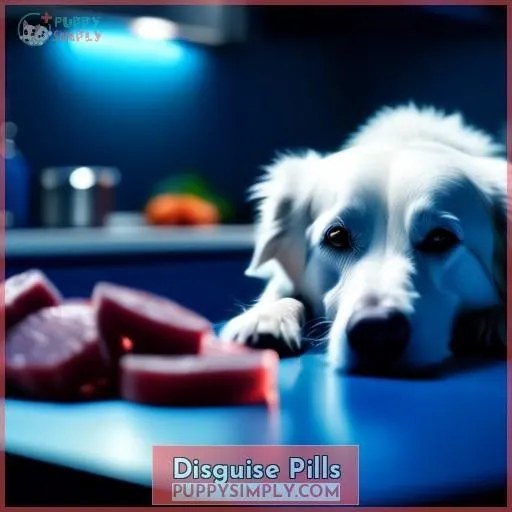This site is supported by our readers. We may earn a commission, at no cost to you, if you purchase through links.

To give your dog a pill, start by disguising it in tasty treats like deli meats or peanut butter. You can also mold the pill into a Pill Pocket™ treat.
For stubborn pups, use a pet piller device to place the pill behind their tongue. Remember to reward your dog with high-value treats afterwards to reinforce good behavior.
If your dog still resists, talk to your veterinarian about flavored or liquid medication alternatives. Following these simple tips will make the process easier for both you and your canine companion.
Table Of Contents
- Key Takeaways
- How to Give a Dog a Pill?
- Disguise Pills
- Give Meds Before Mealtime
- Get a Pet Piller
- Always Reward Your Dog
- Ask Your Vet for Advice
- Frequently Asked Questions (FAQs)
- How do I give a dog a pill if they are resistant to taking it?
- Can I crush a pill for my dog without consulting the vet first?
- How do I give a dog a liquid medication?
- What should I do if my dog spits out a pill or capsule?
- Can I use a pill pusher for my dog if they are nervous or resistant to taking pills?
- Conclusion
Key Takeaways
- Disguise pills in tasty treats or use Pill Pockets to make the process more enjoyable for your dog.
- Use a pet piller device to place the pill behind your dog’s tongue for easy swallowing.
- Consider flavored or liquid medication alternatives if your dog resists taking pills.
- Reward your dog with high-value treats after administering medication to reinforce positive behavior.
How to Give a Dog a Pill?
To give a dog a pill, you can hide it in food such as canned dog food, peanut butter, or cheese. If your dog spits out the pill, you may need to administer it directly into their mouth.
To do this, lubricate the pill with a small amount of gravy or butter, grasp your dog’s muzzle, tilt their head back, and gently open their mouth. Place the pill as far back on their tongue as possible, close their mouth, and encourage swallowing by rubbing their nose or blowing lightly on it.
Always read the prescription label and understand the dosing instructions before administering the medication.
Disguise Pills
Have a picky pup on your hands? Disguise those pills in tasty foods they can’t resist, like deli meats or peanut butter. You can also try molding the pill into a Pill Pocket treat for an easy swallow.
Hand Feed Medicated Food or Treat
To effectively administer medication to your dog, it’s essential to conceal the pills in delectable foods that your dog adores. This can be achieved by hand-feeding medicated food or treats, utilizing pill pockets, or even hiding the pill in a cube of cheese. The objective is to make the process pleasurable for your dog, transforming medication time into a treat session. Always reward your dog after administering medication to reinforce positive behavior.
For instance, you can employ peanut butter, canned food, or meatballs to disguise the pill, ensuring that your dog ingests the entire dosage. Furthermore, you can utilize a pet piller device to insert the medication into the dog’s mouth behind the tongue hump, mitigating the risk of unintentional bites.
Use Pill Pockets™ to Mold Around Pill
After hand-feeding that medicated treat, if your pup’s still on to you, it’s time for a sneaky switch-up. Enter Pill Pockets™. These crafty little disguises cater to treat preferences and dog sizes, ensuring the pill size and shape tuck away nicely. No more pill battles, just tail wags and a gulp.
Give Meds Before Mealtime
Giving your dog a pill can be a challenge, especially if your pet is reluctant. One effective strategy is to give the pill before mealtime, when your dog is more likely to be hungry and less resistant. Here are four steps to make the process easier:
- Use pill concealment: Hide the pill in a treat or food that your dog loves.
- Choose the right pill size: If the pill is too large, it may be difficult for your dog to swallow.
- Consider flavored medication: Ask your vet about flavored compounded medication that may be more palatable for your dog.
- Explore pill alternatives: If your dog refuses to swallow pills, consider liquid or compounded medications.
Get a Pet Piller
Using a pet piller device can be a great option if your dog likes to swallow treats whole. These devices allow you to easily place the pill behind your dog’s tongue, reducing the risk of them spitting it out.
Suitable for Pills That Can Be Given With Food
When it comes to administering medication to your pet, there are several methods you can employ to make the process smoother and more effective. One such method involves using a pet piller, a device designed to deliver pills into the back of your pet’s throat. These devices come in various forms, such as pill guns, syringes, and soft tip dispensers**.
Pill guns, such as the Pet Piller from Santa Cruz Animal Health, are designed to administer one tablet or capsule orally to dogs, cats, and other small animals. They’re particularly beneficial for owners of pets that are difficult to pill, as they place the medication directly into the back of the animal’s throat, allowing it to be swallowed immediately. These devices are made with a soft latex rubber tip that’s gentle to the animal’s mouth and easy to clean.
Syringes, like the one from Chewy.com, are another option for administering medication. These syringes are designed to hold the pill or capsule in place and can be used to deliver the medication directly into the pet’s mouth. The soft tip of the syringe is designed to touch the pill to the front of the throat and then use the push rod to push the pill out, allowing the pet to swallow it by itself.
Soft tip dispensers, like the one from Amazon, are also available. These devices have a soft rubber split top that holds the medication and can be used to deliver the pill to the back of the pet’s throat. They’re designed to be easy to use and can help make the process of giving medication to your pet less stressful for both you and your pet.
When using any of these devices, it’s essential to adhere to the instructions provided by the manufacturer and to ensure that the pill is placed in the correct position for proper administration. It’s also crucial to use the device gently and to avoid forcing the pill down the pet’s throat, as this can cause discomfort or injury.
Hide Pill in Pill Pocket or Cheese
To give a dog a pill, you can hide it in a Pill Pocket or cheese. This method is suitable for pills that can be ingested with food. Pill Pockets are a popular choice for disguising pills, as they’re designed to hide pills without altering the flavor of the treat.
Cheese is another option, as many dogs love the taste. When using this method, make sure the pill is appropriately sized for the Pill Pocket or cheese. For larger pills, you may need to use a syringe to deliver the medication directly into the dog’s mouth.
Always remember to reward your dog after administering medication. If you’re unsure about how to give a dog a pill, ask your veterinarian for a demonstration.
Works Best for Dogs That Swallow Treats Whole
If your dog inhales treats like a vacuum, a pet piller can be a game-changer. It’s perfect for any pill size, dog’s age, or breed, and sidesteps their treat preferences entirely.
| Pill Size | Dog’s Age |
|---|---|
| Small | Puppy |
| Large | Adult |
| Dog’s Breed | Treat Preferences |
| ————- | ——————- |
| Small | Picky Eater |
| Large | Treat Gobbler |
| Pill Frequency | Safety |
| —————- | ——– |
| Daily | Guaranteed |
| As Needed | Protected |
Always Reward Your Dog
After grasping the diverse methods to give pills to your canine companion, it’s imperative to maintain their enthusiasm and contentment. Positive reinforcement serves as a potent tool in dog training and can enhance the experience of administering medication.
Reward Options
When it comes to rewarding your furry friend, there’s an array of choices available. Treats remain a popular option, but they aren’t the sole choice. Your dog may also show a positive response to verbal praise, toys, or physical affection. The key lies in identifying what drives your dog the most and utilizing it as a reward.
Treat Motivation
Treats are an effective means of motivating your dog, but they should be used sparingly. High-value treats, crafted with natural ingredients, are more effective than inferior treats. It’s also paramount to take into account your dog’s dietary needs and adjust the quantity of treats accordingly.
Timing of Reward
Rewarding your dog swiftly after desirable behavior is paramount for positive reinforcement to be effective. If you delay too long, your dog may fail to associate the reward with the desired behavior. Hence, it’s important to give your dog a treat as soon as they swallow the pill.
Reward Consistency
Consistency is a cornerstone of positive reinforcement training. This entails rewarding your dog each time they exhibit the desired behavior. This helps to solidify the behavior and increases the likelihood of your dog repeating it in the future.
Positive Reinforcement
Positive reinforcement is a powerful tool in dog training. It involves rewarding your dog for desirable behavior, rather than punishing them for undesirable behavior. This approach fosters a positive learning environment and strengthens the bond between you and your canine companion.
Ask Your Vet for Advice
If your dog is stubborn about taking pills, ask your vet about flavored compounded medications. Be sure to follow the vet’s instructions carefully when giving your dog any medication.
Ask About Flavored Compounded Medication
Consult Your Veterinarian for Guidance: Tips for Administering Medication to Your Pet
When administering medication to your pet, it’s imperative to minimize stress and facilitate the process. One effective strategy is to seek advice from your veterinarian regarding flavored compounded medication. Here are some recommendations:
- Consider Dietary Preferences: Determine the natural dietary habits of your pet. Omnivores may prefer flavors such as meat, poultry, or fish, while herbivores may favor sweet flavors like Tutti Frutti or pina colada.
- Select an Acceptable Flavor: The aroma of the medication is also significant. For instance, cats may be averse to bitter scents and find sweet flavors more acceptable. Small animals like rabbits, birds, and gerbils typically prefer flavors consistent with their natural diets.
- Adhere to Veterinary Instructions: Always follow the veterinarian’s instructions for administering the medication, including specific dosing guidelines.
- Evaluate Compounding Safety: Confirm that the compounding process is safe for your pet. Discuss any concerns with your veterinarian and inquire about the safety of the compounding procedure.
Follow the Vet’s Instructions Carefully
To guarantee the safety and efficacy of medication administration to your dog, it’s imperative to meticulously adhere to your veterinarian’s instructions. Here are some essential points to bear in mind:
- Comprehend the medication dosage: Verify that you’re administering the appropriate dosage based on your dog’s weight, medical history, and the specific medication prescribed by your vet.
- Pill size, shape, and texture: Some dogs may encounter difficulties swallowing larger or oddly shaped pills, so inquire with your vet if there are alternative formulations of the medication available.
- Pill taste: Some medications may possess a bitter or unpalatable taste that can dissuade your dog from ingesting them. Inquire with your vet if there are palatable compounded medications or if the pill can be pulverized and incorporated into food.
- Abide by label instructions: Always peruse the label meticulously and adhere to the recommended route of administration, dosing frequency, and duration of treatment.
- Solicit clarification: If you’re uncertain about any facet of the medication administration, don’t hesitate to seek clarification from your vet. They’re available to assist and guide you through the process.
Frequently Asked Questions (FAQs)
How do I give a dog a pill if they are resistant to taking it?
Don’t stress – there are tricks to get stubborn pups to swallow pills. Try hiding it in tasty food or using a piller device. With patience and positivity, you’ve got this!
Can I crush a pill for my dog without consulting the vet first?
Nope, don’t crush that pill without a chat with your vet first. They’ll know if it’s safe to alter the medication and can advise the best way to give it to your pup.
How do I give a dog a liquid medication?
Steady your pup’s head, gently part their lips, and carefully insert the syringe behind their canine tooth. Slowly squirt the liquid medicine onto their tongue while praising them – they’ll swallow it down in a snap!
What should I do if my dog spits out a pill or capsule?
If your pup spits out a pill, don’t fret! Just hide it in their favorite treat or food instead. That’ll do the trick and get the meds down smoothly.
Can I use a pill pusher for my dog if they are nervous or resistant to taking pills?
Absolutely, a pill pusher can be your dog’s knight in shining armor! This nifty gadget takes the hassle out of pill time, making it a breeze for even the most reluctant pup. Give it a try – your furry friend will be grateful.
Conclusion
Giving your pup a pill doesn’t have to be a battle. By mastering the art of disguise with tasty treats, you can make the process a breeze.
Using a pet piller can also help. If your dog still resists, don’t hesitate to consult your veterinarian about flavored or liquid medication alternatives.











